Eye yoga’s a fantastic way to enhance your vision and overall eye health. By practicing simple techniques like palming and pencil push-ups, you can reduce digital eye strain and improve eye coordination. Just ten minutes a day can lead to noticeable improvements. Incorporating the 20-20-20 rule helps protect your eyes during screen time. Curious about how to implement these strategies and more? You’ll discover essential tips and nutrition guidelines that boost your eye health even further.
Key Takeaways
- Eye yoga enhances vision by strengthening eye muscles and improving flexibility through simple exercises practiced daily.
- Techniques like rotating eyes and alternating focus boost coordination and alleviate digital eye strain symptoms.
- Incorporating palming and blinking exercises promotes relaxation and maintains eye moisture during prolonged screen use.
- The 20-20-20 rule is essential for eye care, encouraging breaks every 20 minutes to reduce discomfort and improve focus.
- A nutrient-rich diet with antioxidants and hydration supports overall eye health, complementing eye yoga practices for optimal results.
Benefits of Eye Yoga
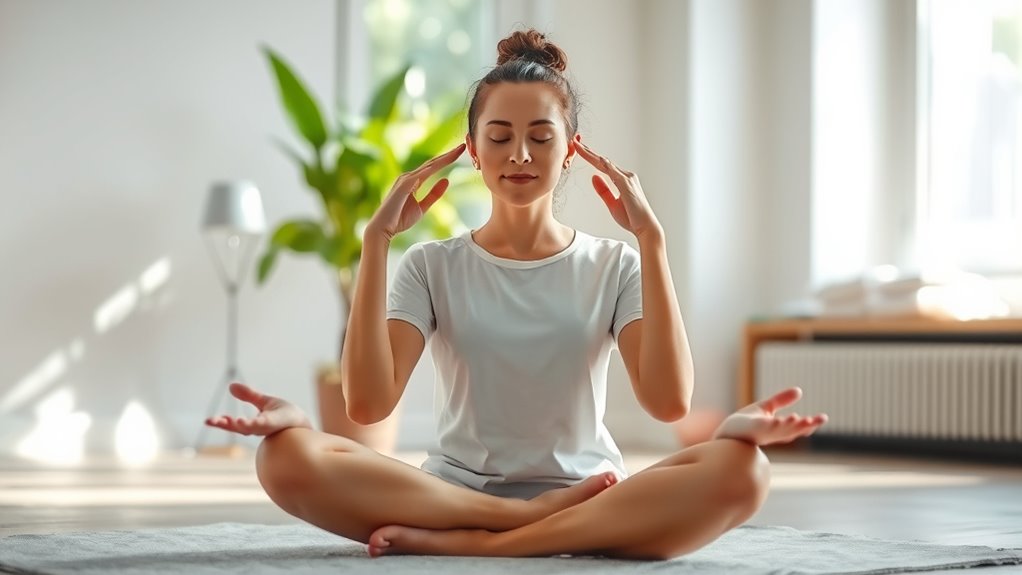
If you’re looking to enhance your vision and overall eye health, eye yoga offers a range of benefits that can make a real difference. Regular practice strengthens your eye muscles and improves flexibility, which can elevate your visual performance.
By incorporating eye yoga into your routine, you might find relief from digital eye strain symptoms like dryness and fatigue. Techniques such as palming and blinking encourage relaxation and stimulate tear production, keeping your eyes moist and comfortable.
Additionally, eye yoga can help improve coordination between your eyes, addressing issues like strabismus and amblyopia. For lasting results, consider discussing these practices with your eye doctor’s office to guarantee they fit well with your overall eye health strategy.
Essential Eye Yoga Techniques
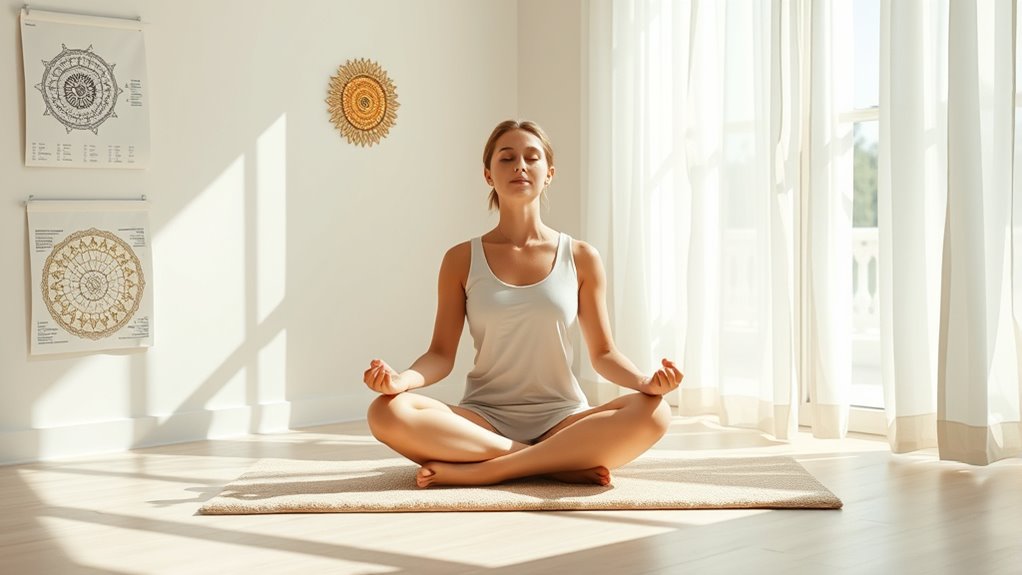
To improve your eye health and relieve strain, incorporating essential eye yoga techniques into your daily routine can be highly beneficial.
Start with simple exercises like rotating your eyes in circles to enhance flexibility. Alternate your focus between near and far objects to strengthen your eye muscles.
Try incorporating deep breathing while performing these movements; it increases blood circulation to your eyes, enhancing relaxation. Even just 10 minutes a day can lead to noticeable improvements, especially if you spend long hours in front of screens.
Incorporating deep breathing with eye exercises can significantly enhance relaxation and improve your eye health in just 10 minutes a day.
If you experience persistent discomfort, don’t hesitate to consult an eye doctor for personalized advice.
Regular practice of these techniques can greatly boost your visual acuity and overall eye comfort.
Palming: A Relaxation Technique
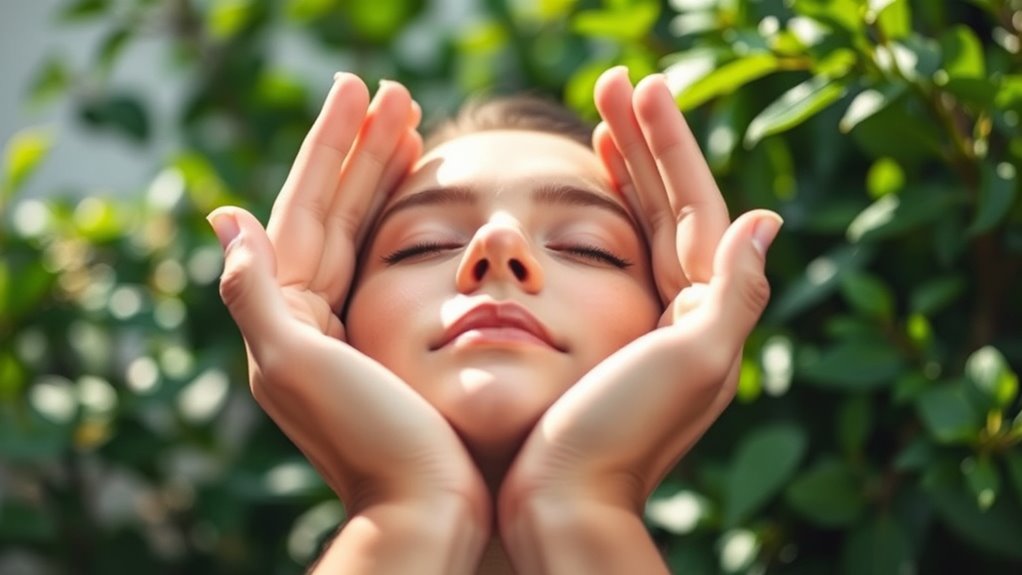
Incorporating relaxation techniques into your eye care routine can greatly enhance the benefits of eye yoga. One effective method is palming, a simple exercise designed to relax your eye muscles and alleviate eyestrain. To practice palming, rub your hands together to generate warmth, close your eyes, and gently place your palms over your cheekbones. Breathe deeply for about five minutes to block out light and let your eyes rest.
| Step | Action | Duration |
|---|---|---|
| 1 | Rub hands together | 30 seconds |
| 2 | Close your eyes | – |
| 3 | Place palms over cheekbones | – |
| 4 | Breathe deeply | 5 minutes |
Regularly incorporating palming can relieve tension and rejuvenate your eyes!
Blinking: Restoring Eye Moisture

Blinking is essential for keeping your eyes moist and comfortable, especially if you’re staring at screens for long periods.
You mightn’t realize it, but your blink rate can drop considerably when focused on digital devices.
Importance of Blinking
Your eyes rely on a simple yet essential action—blinking—to stay healthy and moist. Blinking replenishes the tear film, important for maintaining moisture and reducing dryness.
You might blink about 15-20 times per minute, but this can drop considerably during long screen time, leading to discomfort. Conscious blinking, where you close your eyes for two seconds, stimulates oil glands to prevent tear evaporation.
Regularly practicing blinking exercises helps alleviate eyestrain, fatigue, and dryness, especially if you often use digital devices. Plus, implementing the 20-20-20 rule—looking at something 20 feet away every 20 minutes—promotes natural blinking, helping to improve your eyesight.
Don’t overlook this crucial action; it’s key to your eye health.
Techniques to Blink Effectively
Although it might seem like a simple act, effective blinking is essential for restoring eye moisture and combating dryness. Conscious blinking helps maintain your tear film, especially after long hours on digital devices. To practice, try this technique: close your eyes tightly for two seconds, then open them. This stimulates your oil glands, enhancing moisture retention. Remember the 20-20-20 rule: every 20 minutes, take a break, look at something 20 feet away, and blink intentionally to relieve eyestrain. Regularly incorporating these habits can greatly reduce fatigue and dryness, promoting overall eye health.
| Technique | Description | Benefits |
|---|---|---|
| Conscious Blinking | Close eyes for 2 seconds | Restores tear film |
| 20-20-20 Rule | Break every 20 minutes | Reduces strain |
| Tight Blinking | Squeeze eyelids tightly | Enhances moisture retention |
| Eye Exercises | Move eyes in different directions | Improves flexibility |
| Regular Breaks | Pause work periodically | Reduces fatigue |
Pencil Push-ups: Training Convergence

Pencil push-ups can greatly improve your eye coordination and ease symptoms like eyestrain.
To get the most out of this exercise, it’s essential to master the proper technique and follow recommended frequency and duration guidelines.
Let’s explore the benefits and how to effectively incorporate pencil push-ups into your routine.
Benefits of Pencil Push-ups
Many people can benefit from incorporating pencil push-ups into their vision care routine. These exercises to improve eye convergence help you train your eyes to work together effectively when focusing on nearby objects.
As you hold a pencil at arm’s length and bring it closer while keeping your gaze fixed on the tip, you enhance your eye coordination. If you notice the pencil image doubling, it’s a sign to move it back, reinforcing proper convergence techniques.
Regular practice can alleviate symptoms of convergence insufficiency, like reading difficulties and eye strain. Suitable for all ages, pencil push-ups are often recommended as part of vision therapy for those struggling with eye coordination issues.
Start practicing today for better visual comfort!
Proper Technique Explained
To effectively strengthen your eye convergence, mastering the proper technique for pencil push-ups is key. Follow these steps to perform the exercise correctly:
- Position the Pencil: Hold a pencil at arm’s length, ensuring the tip is clearly visible.
- Focus: Concentrate on the tip of the pencil as you slowly move it toward your nose. Maintain your focus throughout the movement.
- Stop if Doubled: If you see double, stop moving the pencil. This indicates your convergence limit.
Repeat this process several times, gradually bringing the pencil closer each time.
Regular practice of pencil push-ups can help alleviate symptoms of convergence insufficiency, enhancing your overall visual coordination and reading performance.
Frequency and Duration Recommendations
Practicing pencil push-ups daily for about 10 minutes can greatly improve your eye convergence. The recommended frequency is to perform these exercises consistently, aiming for 10 to 15 repetitions per session.
Each time, move the pencil towards your nose while keeping your focus until the image doubles. Then, return to the starting position. This duration and frequency help strengthen the eye muscles responsible for convergence.
Consistency is key; by incorporating pencil push-ups into your daily routine, you’ll notice significant improvements in your visual coordination and a reduction in symptoms related to convergence insufficiency.
For best results, consider adding these exercises to a broader routine of eye workouts to further enhance your overall visual skills and support better eye health.
Near and Far Focus: Enhancing Flexibility

While digital devices dominate our daily lives, the Near and Far Focus exercise offers a practical way to enhance your eye flexibility.
This exercise involves shifting your gaze between a thumb held 10 inches away and a target 20 feet away. Here’s how to do it effectively:
- Focus on your thumb for about 15 seconds, allowing your eyes to adjust to the near distance.
- Shift your gaze to the distant target for another 15 seconds, engaging your focusing system for far vision.
- Repeat this cycle several times to improve adaptability between near and far objects.
Incorporating this exercise into your routine can greatly reduce digital eye strain symptoms, enhancing visual comfort during prolonged near work.
Your eyes will thank you!
The 20-20-20 Rule: Protecting Your Eyes
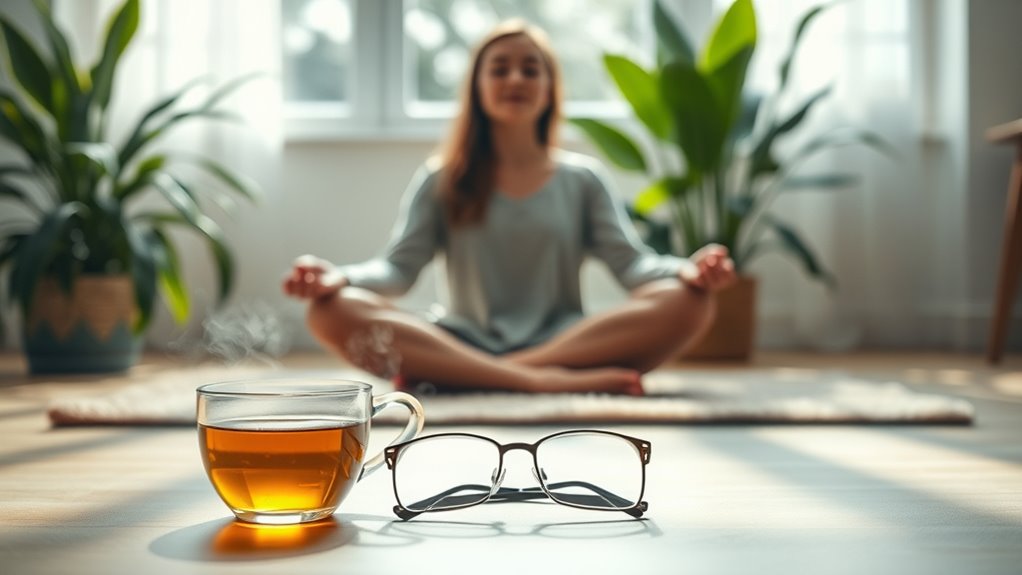
To protect your eyes from digital strain, you should follow the 20-20-20 Rule.
Every 20 minutes, take a break and look at something 20 feet away for at least 20 seconds.
It’s a simple way to give your eyes the rest they need while working on screens.
Preventing Digital Eye Strain
Digital eye strain can be a real hassle, especially for those who spend long hours in front of screens. One effective way to reduce eye strain is by following the 20-20-20 rule. Here’s how it works:
- Every 20 minutes of screen time, take a break.
- Look at something 20 feet away.
- Hold your gaze for 20 seconds.
This simple practice helps alleviate dryness, fatigue, and discomfort from prolonged screen use. By regularly implementing the 20-20-20 rule, you can greatly improve your overall eye comfort and productivity.
Plus, it aids in preventing long-term vision issues linked to excessive screen time. Incorporating this rule into your daily routine is an easy way to maintain eye health while enjoying your digital devices.
Simple Implementation Techniques
Many people find it challenging to remember to take breaks during long hours of screen time, but implementing the 20-20-20 Rule can be straightforward and highly effective. Every 20 minutes, look at something 20 feet away for at least 20 seconds to relax your eyes. This simple act can greatly reduce symptoms like dryness and fatigue. Additionally, seeking emotional support during stressful times can enhance your overall well-being.
| Step | Action |
|---|---|
| 1 | Set a timer for 20 mins |
| 2 | Look at a distant object |
| 3 | Focus for 20 seconds |
| 4 | Repeat every 20 mins |
Following the 20-20-20 Rule helps maintain your eye’s flexibility, contributing to long-term comfort and health, especially during intensive visual tasks.
Incorporating Eye Yoga Into Daily Routine
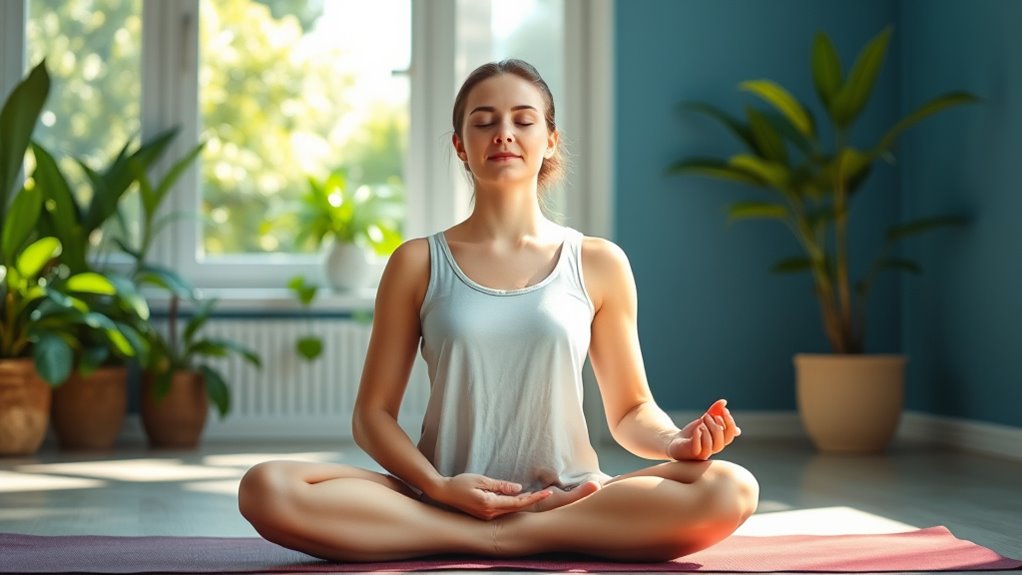
Incorporating eye yoga into your daily routine can be simple and effective, especially if you dedicate just 10 minutes a day to practice.
You can improve your eye health and reduce strain by following these steps:
- Follow the 20-20-20 Rule: Every 20 minutes of screen time, look at something 20 feet away for 20 seconds to relieve fatigue.
- Practice Eye Movements: Rotate your eyes in different directions and draw geometric figures with your gaze. This enhances flexibility and coordination.
- Combine Techniques: Integrate good posture and breathing exercises during your eye yoga sessions to maximize relaxation.
Set reminders in your workspace to create a consistent practice, reinforcing the importance of regular breaks for ideal vision.
Nutrition for Eye Health

To truly enhance your eye health, paying attention to nutrition is just as important as practicing eye yoga. A diet rich in antioxidants like vitamins C and E, zinc, and omega-3 fatty acids can protect against age-related macular degeneration and cataracts.
Enhance your eye health by prioritizing nutrition alongside eye yoga for optimal protection against vision issues.
Incorporate leafy greens like spinach and kale, fish such as salmon and tuna, nuts, and citrus fruits into your meals for ideal eye health.
Don’t forget carotenoids! Lutein and zeaxanthin found in colorful fruits and vegetables filter harmful blue light and reduce retinal damage. Foods high in beta-carotene, like carrots and sweet potatoes, promote better vision.
Finally, stay hydrated to maintain moisture balance and tear production—key components for clear vision.
Prioritize nutrition for eye health, and your eyes will thank you!
Community Engagement and Support
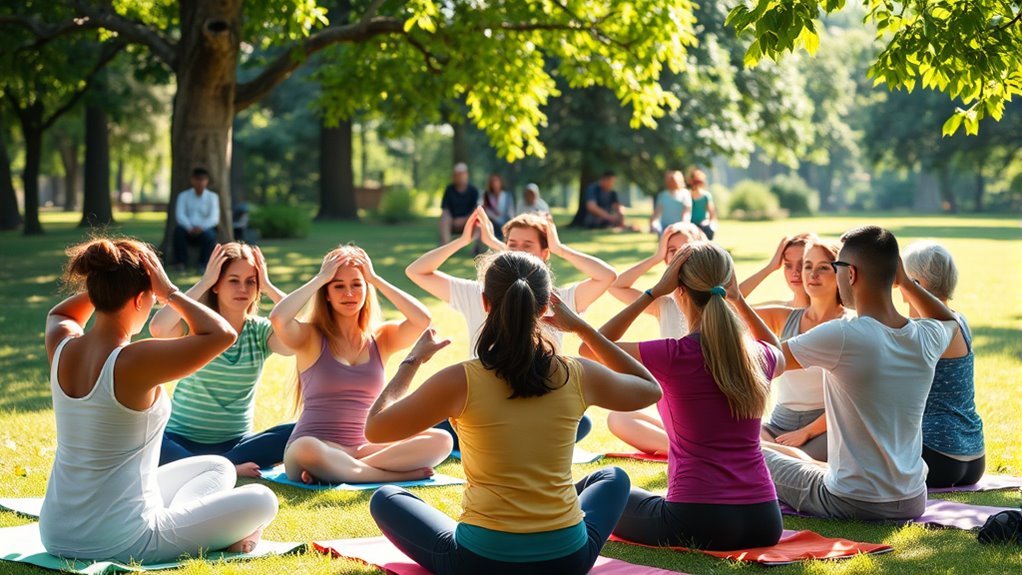
Connecting with a community focused on eye health can be a game changer for your vision improvement journey. Engaging with others not only keeps you motivated but also helps you stay accountable in maintaining a regular eye exercise routine.
Here are a few ways to enhance your community engagement:
- Share Your Experiences: By sharing personal successes in eye yoga, you can inspire others and create a supportive atmosphere.
- Join Online Groups: Participate in forums or social media groups dedicated to eye care to exchange tips and discover new eye exercise techniques.
- Collaborate on Practices: Working with others on eye yoga can make the experience more enjoyable and effective, promoting consistency and long-term benefits for everyone involved.
Frequently Asked Questions
Can Eye Yoga Improve Eyesight?
Can eye yoga improve eyesight?
While it won’t correct refractive errors like myopia or astigmatism, you might find that regular practice helps reduce eye strain and enhances visual comfort.
By incorporating eye yoga into your routine, you can strengthen the coordination between your eyes and improve focusing abilities, especially if you spend a lot of time on close work.
Just remember to consult an eye care professional for personalized advice.
Can You Correct Your Vision With Eye Exercises?
Imagine your eyes as a pair of well-tuned instruments, needing regular practice to hit the right notes.
While eye exercises can enhance your visual skills and ease strain, they won’t fix refractive errors like myopia or astigmatism.
Think of them as a workout for your eye muscles, improving flexibility and coordination.
For tailored advice, consult an eye care professional who can guide you on the best exercises for your unique vision needs.
How Can I Sharpen My Eyesight Naturally?
To sharpen your eyesight naturally, start by practicing the 20-20-20 rule; every 20 minutes, take a 20-second break to look at something 20 feet away.
Incorporate pencil push-ups to strengthen your focus on nearby objects.
Don’t forget to relax your eyes with palming, and regularly alternate your focus between near and far objects.
Finally, maintain a balanced diet rich in vitamins A, C, and omega-3 fatty acids to support long-term vision health.
What Simple Trick Will Improve Your Vision to 20 20 in 7 Days?
Imagine you’re staring at your screen for hours, feeling that strain.
To improve your vision to 20/20 in just seven days, try the 20-20-20 rule. Every 20 minutes, look at something 20 feet away for 20 seconds. This simple trick helps reduce eye fatigue and enhances focus.
If you add near and far focus exercises, you’ll boost your eye’s flexibility. Just ten minutes a day can lead to noticeable improvements in your vision!
Conclusion
Incorporating eye yoga into your daily routine can truly transform your vision and overall eye health. As the saying goes, “The eyes are the window to the soul,” so let’s take care of them! By practicing techniques like palming, blinking, and the 20-20-20 rule, you’re not just improving sight but also nurturing your well-being. Remember, a little stretch goes a long way, so give your eyes the love they deserve and watch your world become clearer.










